Detailed 8-Hour Nursing Care Plan for Patient Thi Minh Tran
VerifiedAdded on 2022/07/28
|9
|1030
|22
Report
AI Summary
This nursing care plan outlines an 8-hour afternoon shift for patient Thi Minh Tran, addressing conditions such as hypotension, pyrexia, high respiratory rate, dehydration, confusion, delirium, and urinary tract infection (UTI). The plan details specific interventions, including medication administration (midodrine, acetaminophen, intravenous ampicillin and gentamycin), oxygen therapy, and intravenous sodium chloride, along with rationales for each. It emphasizes the importance of consulting allied health professionals like cardiologists, nutritionists, neurologists, urologists, and nurses for comprehensive care. Regular assessments of vital signs, body temperature, respiratory rate, urine output, and cognitive function are included to monitor the patient's condition and adjust interventions accordingly. Patient safety measures, such as fall risk tracking and environmental modifications, are also highlighted to prevent injuries related to confusion and delirium.
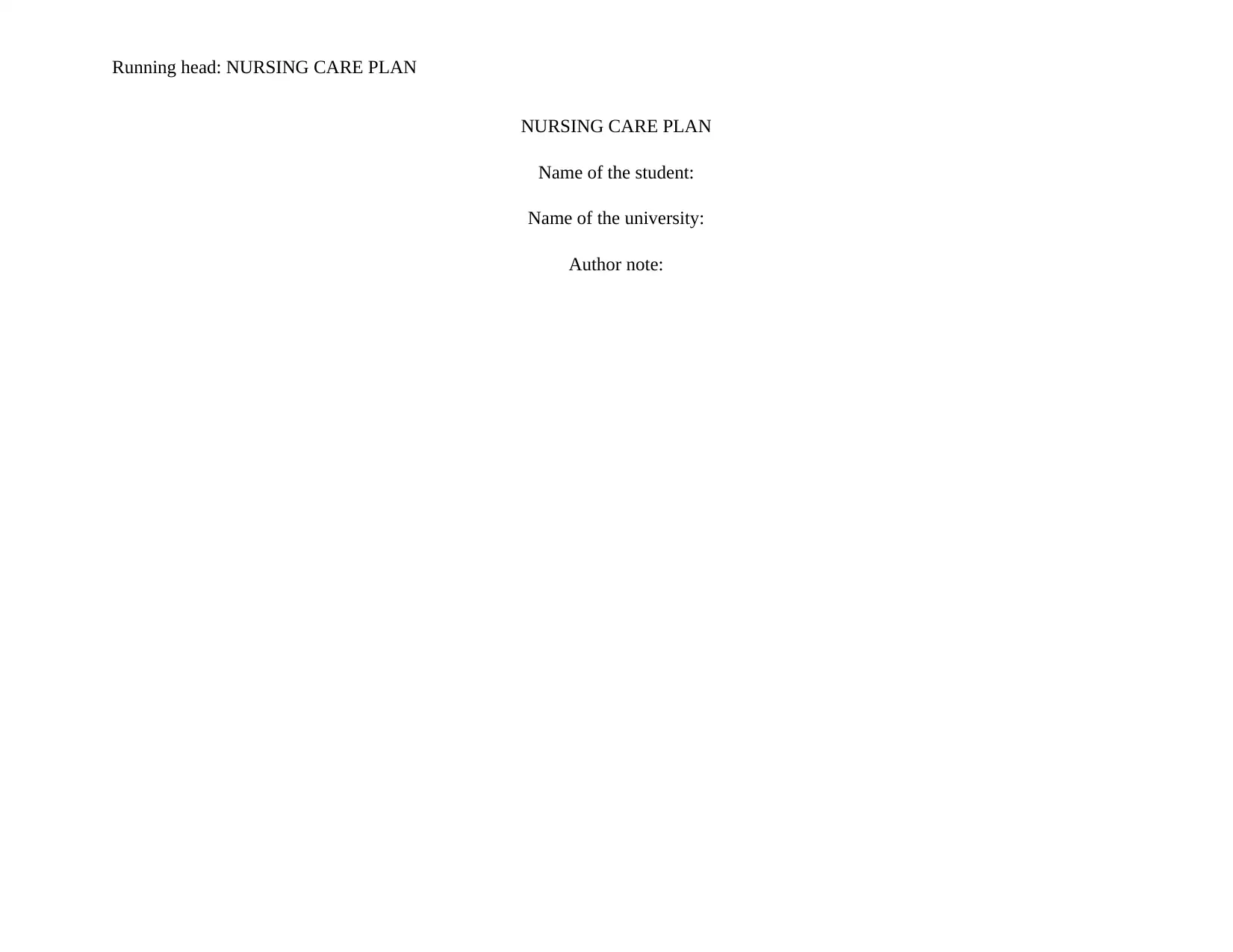
Running head: NURSING CARE PLAN
NURSING CARE PLAN
Name of the student:
Name of the university:
Author note:
NURSING CARE PLAN
Name of the student:
Name of the university:
Author note:
Paraphrase This Document
Need a fresh take? Get an instant paraphrase of this document with our AI Paraphraser
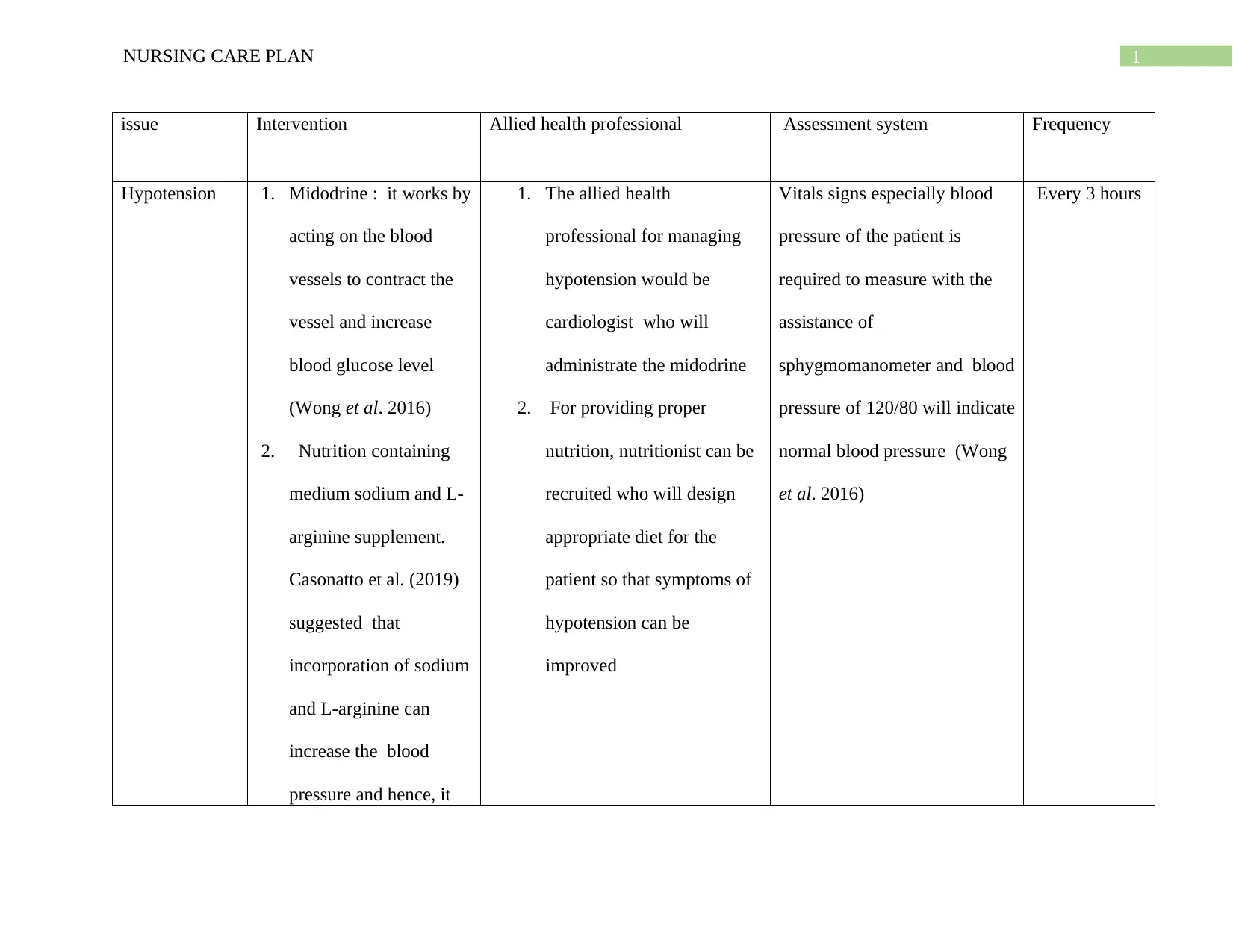
1NURSING CARE PLAN
issue Intervention Allied health professional Assessment system Frequency
Hypotension 1. Midodrine : it works by
acting on the blood
vessels to contract the
vessel and increase
blood glucose level
(Wong et al. 2016)
2. Nutrition containing
medium sodium and L-
arginine supplement.
Casonatto et al. (2019)
suggested that
incorporation of sodium
and L-arginine can
increase the blood
pressure and hence, it
1. The allied health
professional for managing
hypotension would be
cardiologist who will
administrate the midodrine
2. For providing proper
nutrition, nutritionist can be
recruited who will design
appropriate diet for the
patient so that symptoms of
hypotension can be
improved
Vitals signs especially blood
pressure of the patient is
required to measure with the
assistance of
sphygmomanometer and blood
pressure of 120/80 will indicate
normal blood pressure (Wong
et al. 2016)
Every 3 hours
issue Intervention Allied health professional Assessment system Frequency
Hypotension 1. Midodrine : it works by
acting on the blood
vessels to contract the
vessel and increase
blood glucose level
(Wong et al. 2016)
2. Nutrition containing
medium sodium and L-
arginine supplement.
Casonatto et al. (2019)
suggested that
incorporation of sodium
and L-arginine can
increase the blood
pressure and hence, it
1. The allied health
professional for managing
hypotension would be
cardiologist who will
administrate the midodrine
2. For providing proper
nutrition, nutritionist can be
recruited who will design
appropriate diet for the
patient so that symptoms of
hypotension can be
improved
Vitals signs especially blood
pressure of the patient is
required to measure with the
assistance of
sphygmomanometer and blood
pressure of 120/80 will indicate
normal blood pressure (Wong
et al. 2016)
Every 3 hours
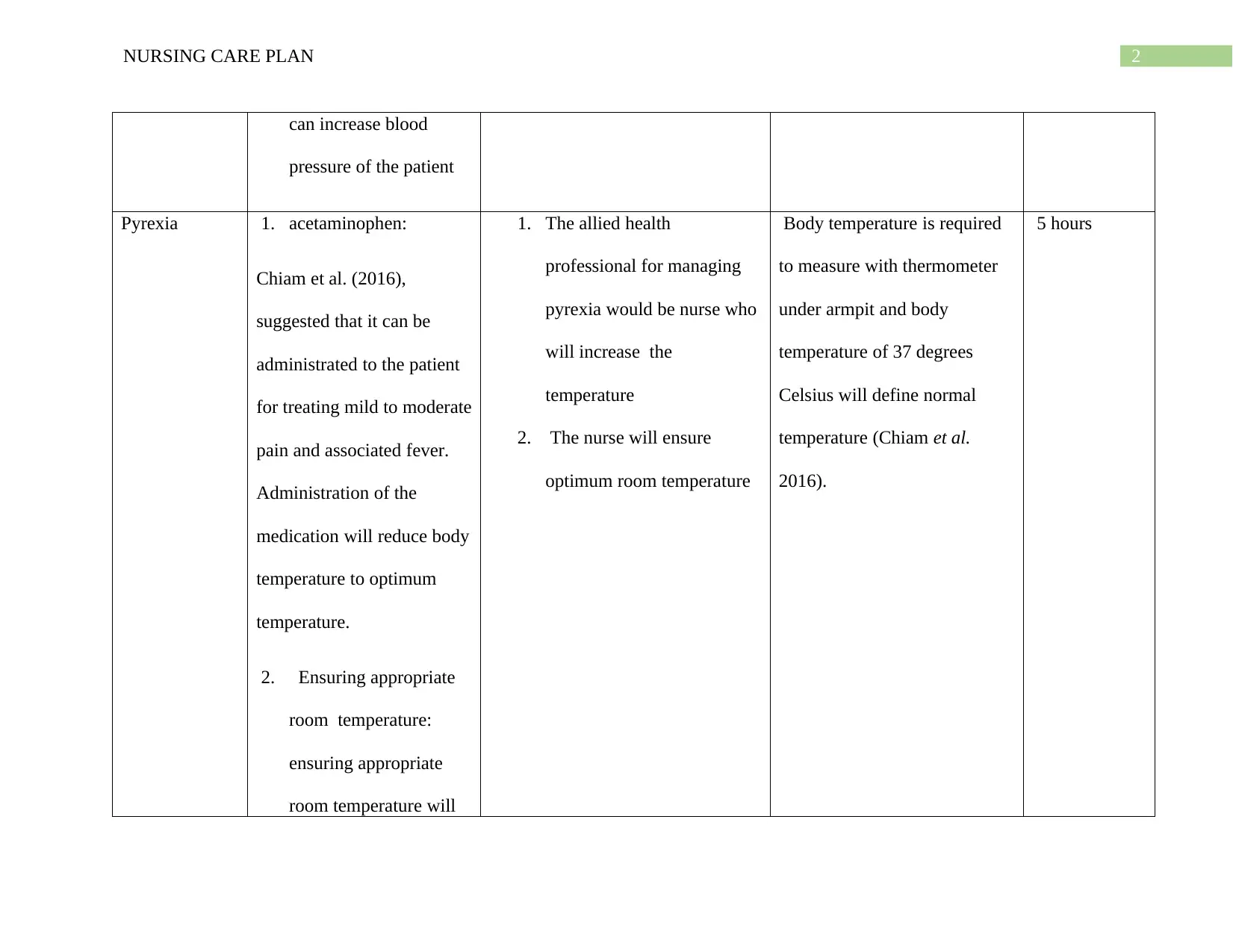
2NURSING CARE PLAN
can increase blood
pressure of the patient
Pyrexia 1. acetaminophen:
Chiam et al. (2016),
suggested that it can be
administrated to the patient
for treating mild to moderate
pain and associated fever.
Administration of the
medication will reduce body
temperature to optimum
temperature.
2. Ensuring appropriate
room temperature:
ensuring appropriate
room temperature will
1. The allied health
professional for managing
pyrexia would be nurse who
will increase the
temperature
2. The nurse will ensure
optimum room temperature
Body temperature is required
to measure with thermometer
under armpit and body
temperature of 37 degrees
Celsius will define normal
temperature (Chiam et al.
2016).
5 hours
can increase blood
pressure of the patient
Pyrexia 1. acetaminophen:
Chiam et al. (2016),
suggested that it can be
administrated to the patient
for treating mild to moderate
pain and associated fever.
Administration of the
medication will reduce body
temperature to optimum
temperature.
2. Ensuring appropriate
room temperature:
ensuring appropriate
room temperature will
1. The allied health
professional for managing
pyrexia would be nurse who
will increase the
temperature
2. The nurse will ensure
optimum room temperature
Body temperature is required
to measure with thermometer
under armpit and body
temperature of 37 degrees
Celsius will define normal
temperature (Chiam et al.
2016).
5 hours
⊘ This is a preview!⊘
Do you want full access?
Subscribe today to unlock all pages.

Trusted by 1+ million students worldwide
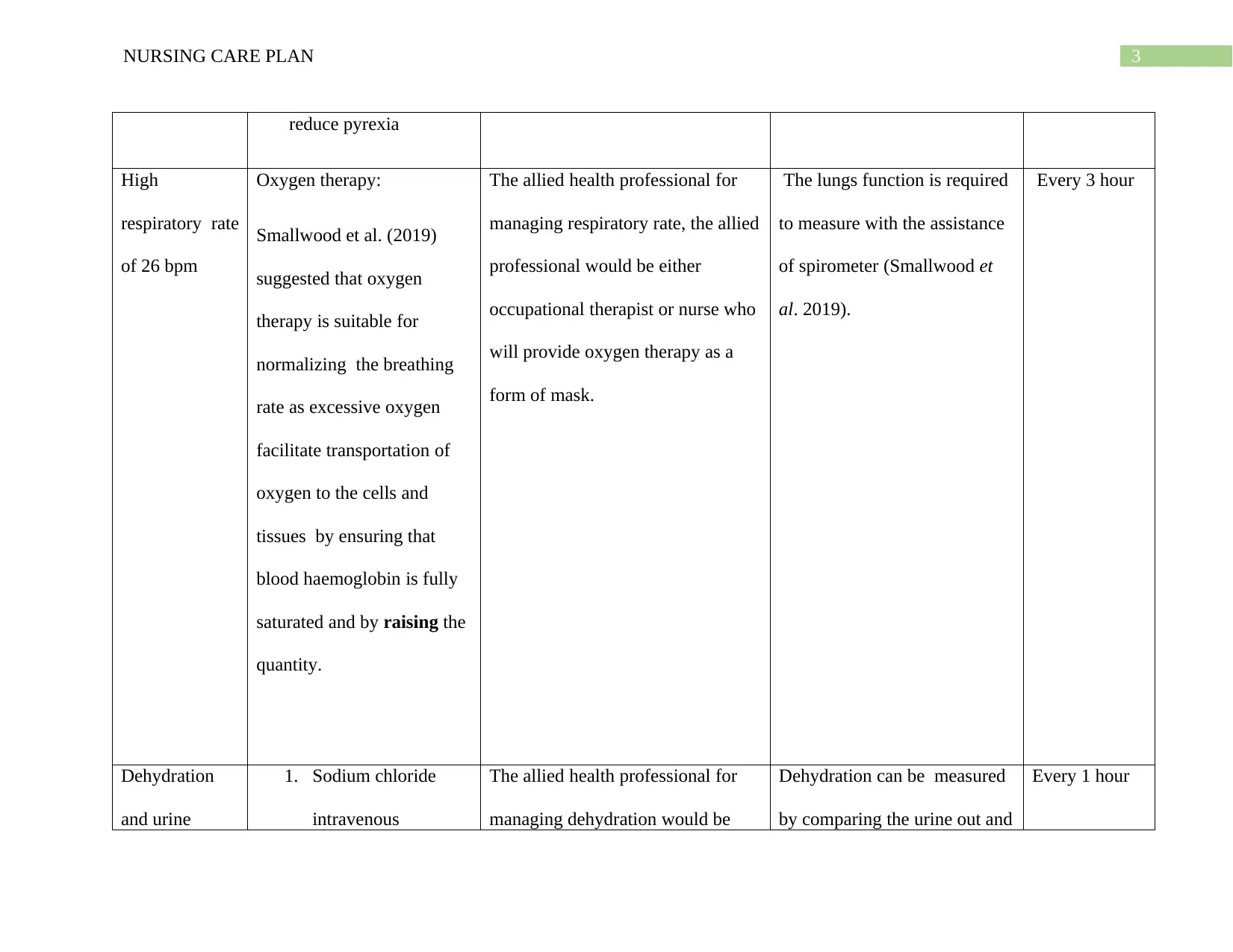
3NURSING CARE PLAN
reduce pyrexia
High
respiratory rate
of 26 bpm
Oxygen therapy:
Smallwood et al. (2019)
suggested that oxygen
therapy is suitable for
normalizing the breathing
rate as excessive oxygen
facilitate transportation of
oxygen to the cells and
tissues by ensuring that
blood haemoglobin is fully
saturated and by raising the
quantity.
The allied health professional for
managing respiratory rate, the allied
professional would be either
occupational therapist or nurse who
will provide oxygen therapy as a
form of mask.
The lungs function is required
to measure with the assistance
of spirometer (Smallwood et
al. 2019).
Every 3 hour
Dehydration
and urine
1. Sodium chloride
intravenous
The allied health professional for
managing dehydration would be
Dehydration can be measured
by comparing the urine out and
Every 1 hour
reduce pyrexia
High
respiratory rate
of 26 bpm
Oxygen therapy:
Smallwood et al. (2019)
suggested that oxygen
therapy is suitable for
normalizing the breathing
rate as excessive oxygen
facilitate transportation of
oxygen to the cells and
tissues by ensuring that
blood haemoglobin is fully
saturated and by raising the
quantity.
The allied health professional for
managing respiratory rate, the allied
professional would be either
occupational therapist or nurse who
will provide oxygen therapy as a
form of mask.
The lungs function is required
to measure with the assistance
of spirometer (Smallwood et
al. 2019).
Every 3 hour
Dehydration
and urine
1. Sodium chloride
intravenous
The allied health professional for
managing dehydration would be
Dehydration can be measured
by comparing the urine out and
Every 1 hour
Paraphrase This Document
Need a fresh take? Get an instant paraphrase of this document with our AI Paraphraser
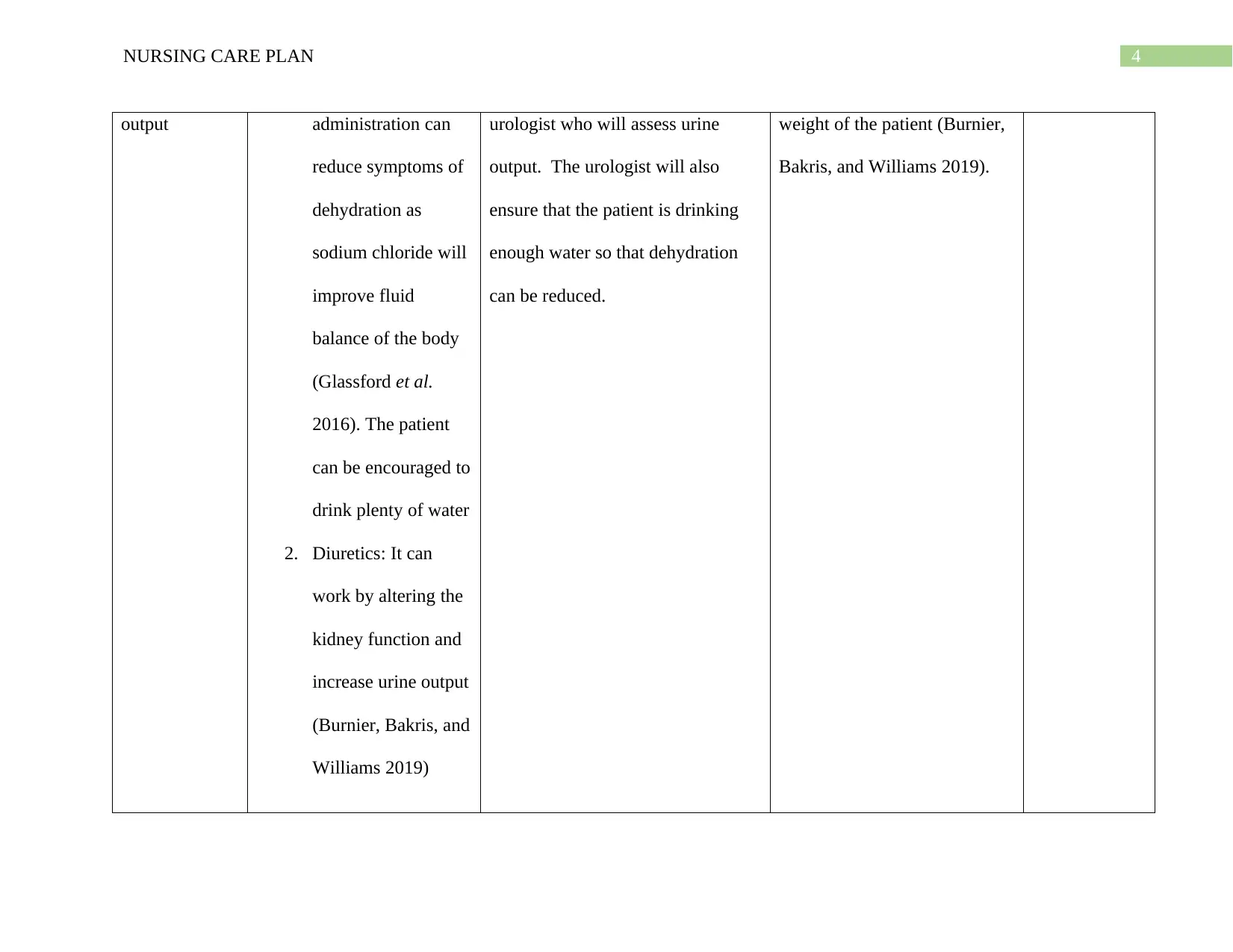
4NURSING CARE PLAN
output administration can
reduce symptoms of
dehydration as
sodium chloride will
improve fluid
balance of the body
(Glassford et al.
2016). The patient
can be encouraged to
drink plenty of water
2. Diuretics: It can
work by altering the
kidney function and
increase urine output
(Burnier, Bakris, and
Williams 2019)
urologist who will assess urine
output. The urologist will also
ensure that the patient is drinking
enough water so that dehydration
can be reduced.
weight of the patient (Burnier,
Bakris, and Williams 2019).
output administration can
reduce symptoms of
dehydration as
sodium chloride will
improve fluid
balance of the body
(Glassford et al.
2016). The patient
can be encouraged to
drink plenty of water
2. Diuretics: It can
work by altering the
kidney function and
increase urine output
(Burnier, Bakris, and
Williams 2019)
urologist who will assess urine
output. The urologist will also
ensure that the patient is drinking
enough water so that dehydration
can be reduced.
weight of the patient (Burnier,
Bakris, and Williams 2019).
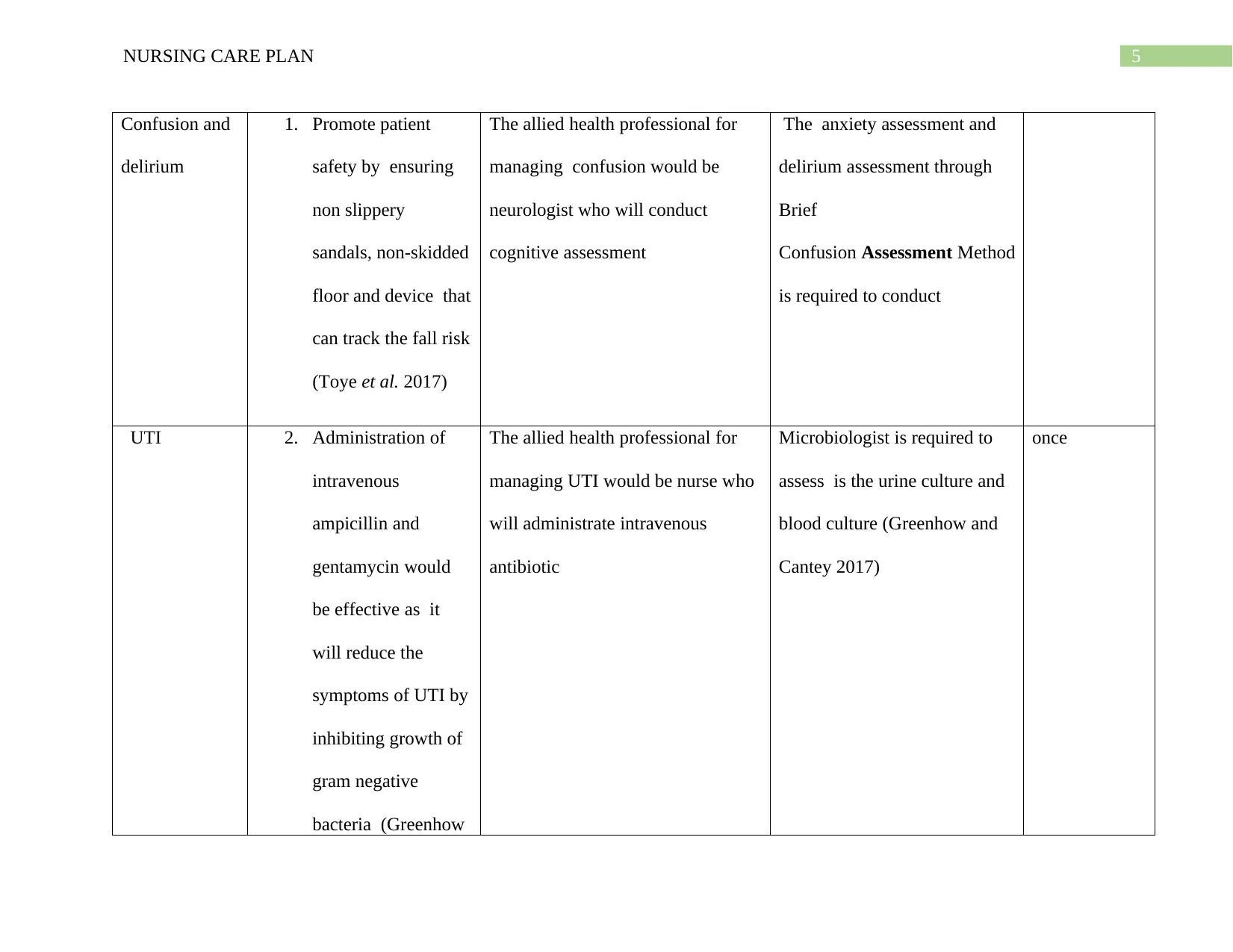
5NURSING CARE PLAN
Confusion and
delirium
1. Promote patient
safety by ensuring
non slippery
sandals, non-skidded
floor and device that
can track the fall risk
(Toye et al. 2017)
The allied health professional for
managing confusion would be
neurologist who will conduct
cognitive assessment
The anxiety assessment and
delirium assessment through
Brief
Confusion Assessment Method
is required to conduct
UTI 2. Administration of
intravenous
ampicillin and
gentamycin would
be effective as it
will reduce the
symptoms of UTI by
inhibiting growth of
gram negative
bacteria (Greenhow
The allied health professional for
managing UTI would be nurse who
will administrate intravenous
antibiotic
Microbiologist is required to
assess is the urine culture and
blood culture (Greenhow and
Cantey 2017)
once
Confusion and
delirium
1. Promote patient
safety by ensuring
non slippery
sandals, non-skidded
floor and device that
can track the fall risk
(Toye et al. 2017)
The allied health professional for
managing confusion would be
neurologist who will conduct
cognitive assessment
The anxiety assessment and
delirium assessment through
Brief
Confusion Assessment Method
is required to conduct
UTI 2. Administration of
intravenous
ampicillin and
gentamycin would
be effective as it
will reduce the
symptoms of UTI by
inhibiting growth of
gram negative
bacteria (Greenhow
The allied health professional for
managing UTI would be nurse who
will administrate intravenous
antibiotic
Microbiologist is required to
assess is the urine culture and
blood culture (Greenhow and
Cantey 2017)
once
⊘ This is a preview!⊘
Do you want full access?
Subscribe today to unlock all pages.

Trusted by 1+ million students worldwide
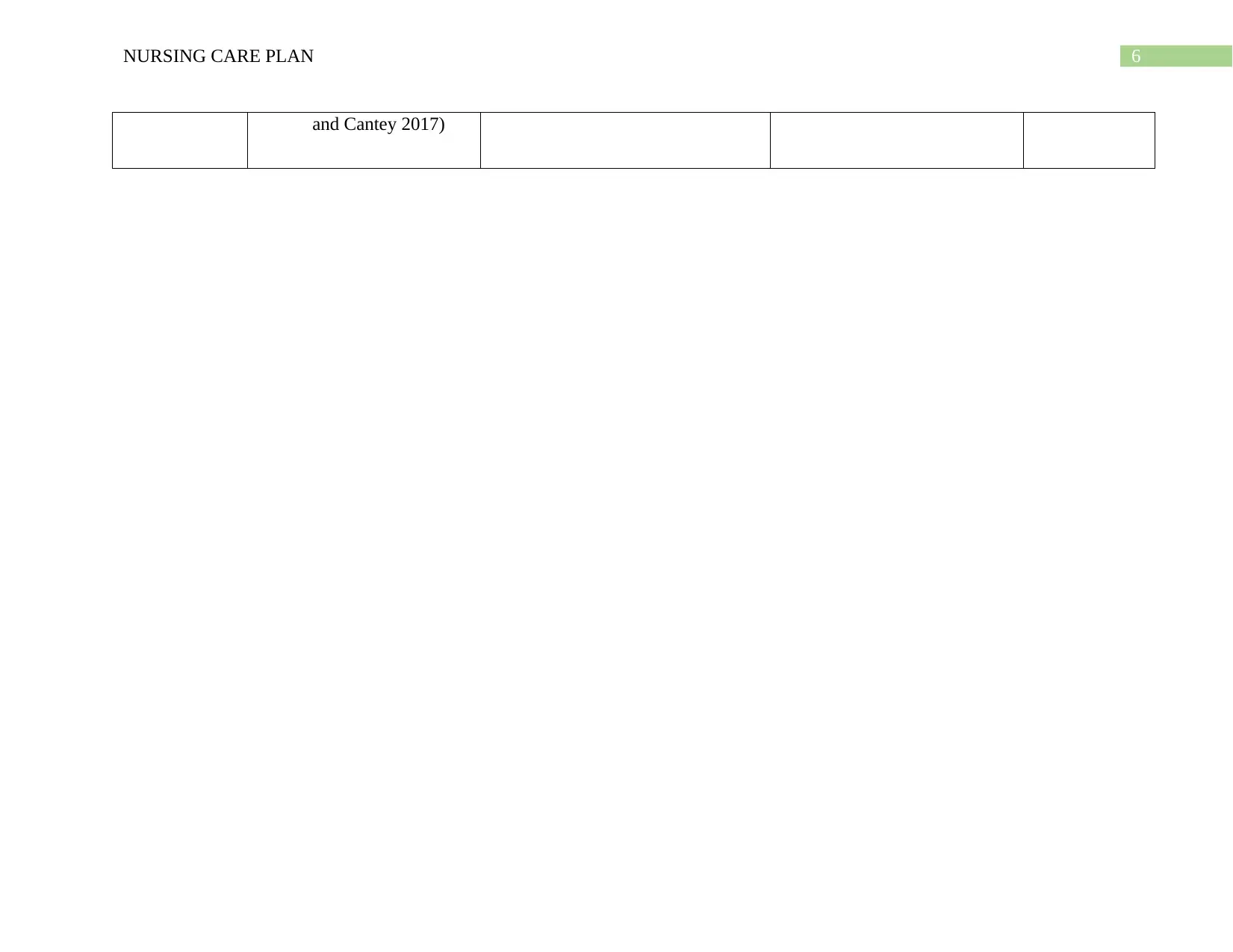
6NURSING CARE PLAN
and Cantey 2017)
and Cantey 2017)
Paraphrase This Document
Need a fresh take? Get an instant paraphrase of this document with our AI Paraphraser
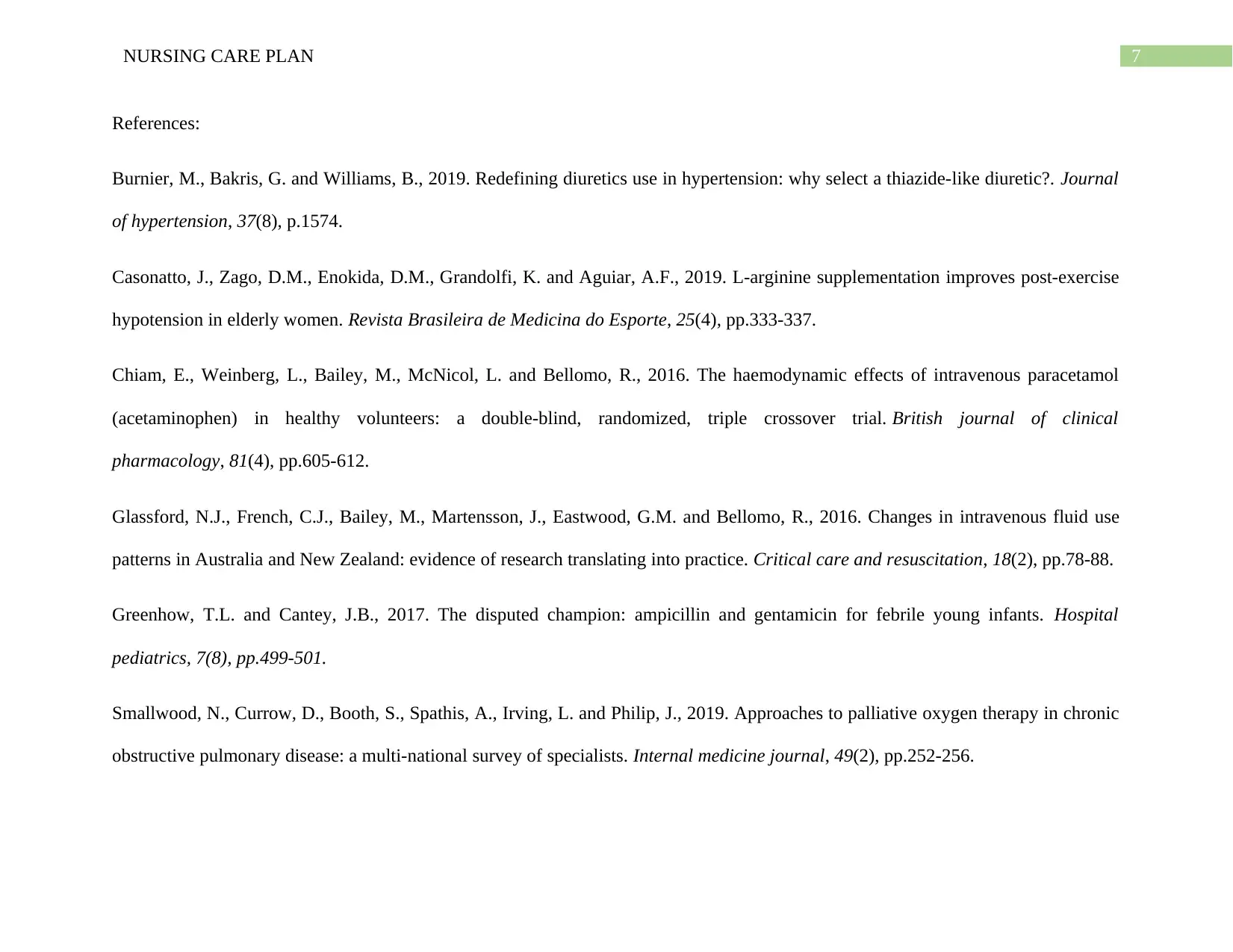
7NURSING CARE PLAN
References:
Burnier, M., Bakris, G. and Williams, B., 2019. Redefining diuretics use in hypertension: why select a thiazide-like diuretic?. Journal
of hypertension, 37(8), p.1574.
Casonatto, J., Zago, D.M., Enokida, D.M., Grandolfi, K. and Aguiar, A.F., 2019. L-arginine supplementation improves post-exercise
hypotension in elderly women. Revista Brasileira de Medicina do Esporte, 25(4), pp.333-337.
Chiam, E., Weinberg, L., Bailey, M., McNicol, L. and Bellomo, R., 2016. The haemodynamic effects of intravenous paracetamol
(acetaminophen) in healthy volunteers: a double‐blind, randomized, triple crossover trial. British journal of clinical
pharmacology, 81(4), pp.605-612.
Glassford, N.J., French, C.J., Bailey, M., Martensson, J., Eastwood, G.M. and Bellomo, R., 2016. Changes in intravenous fluid use
patterns in Australia and New Zealand: evidence of research translating into practice. Critical care and resuscitation, 18(2), pp.78-88.
Greenhow, T.L. and Cantey, J.B., 2017. The disputed champion: ampicillin and gentamicin for febrile young infants. Hospital
pediatrics, 7(8), pp.499-501.
Smallwood, N., Currow, D., Booth, S., Spathis, A., Irving, L. and Philip, J., 2019. Approaches to palliative oxygen therapy in chronic
obstructive pulmonary disease: a multi‐national survey of specialists. Internal medicine journal, 49(2), pp.252-256.
References:
Burnier, M., Bakris, G. and Williams, B., 2019. Redefining diuretics use in hypertension: why select a thiazide-like diuretic?. Journal
of hypertension, 37(8), p.1574.
Casonatto, J., Zago, D.M., Enokida, D.M., Grandolfi, K. and Aguiar, A.F., 2019. L-arginine supplementation improves post-exercise
hypotension in elderly women. Revista Brasileira de Medicina do Esporte, 25(4), pp.333-337.
Chiam, E., Weinberg, L., Bailey, M., McNicol, L. and Bellomo, R., 2016. The haemodynamic effects of intravenous paracetamol
(acetaminophen) in healthy volunteers: a double‐blind, randomized, triple crossover trial. British journal of clinical
pharmacology, 81(4), pp.605-612.
Glassford, N.J., French, C.J., Bailey, M., Martensson, J., Eastwood, G.M. and Bellomo, R., 2016. Changes in intravenous fluid use
patterns in Australia and New Zealand: evidence of research translating into practice. Critical care and resuscitation, 18(2), pp.78-88.
Greenhow, T.L. and Cantey, J.B., 2017. The disputed champion: ampicillin and gentamicin for febrile young infants. Hospital
pediatrics, 7(8), pp.499-501.
Smallwood, N., Currow, D., Booth, S., Spathis, A., Irving, L. and Philip, J., 2019. Approaches to palliative oxygen therapy in chronic
obstructive pulmonary disease: a multi‐national survey of specialists. Internal medicine journal, 49(2), pp.252-256.
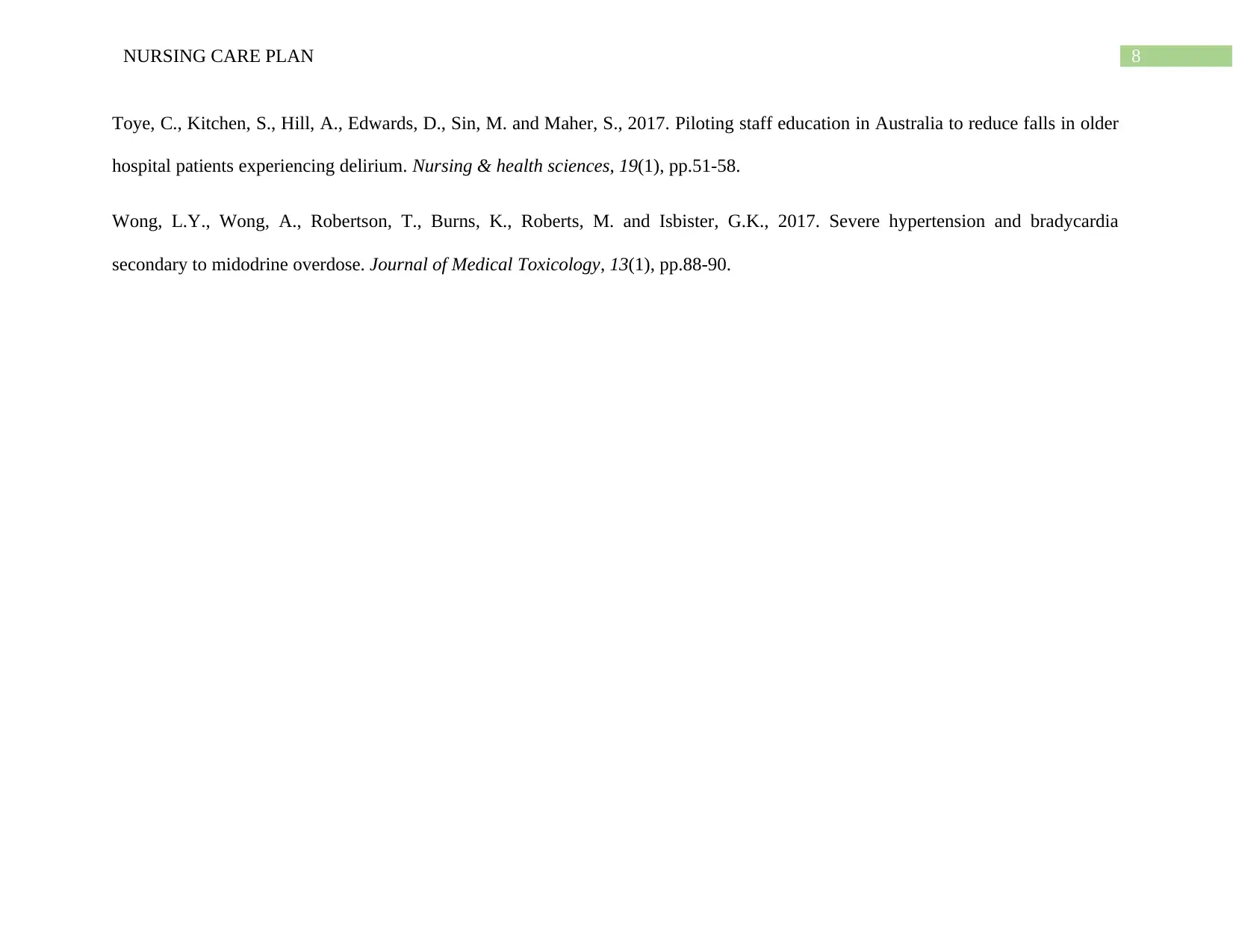
8NURSING CARE PLAN
Toye, C., Kitchen, S., Hill, A., Edwards, D., Sin, M. and Maher, S., 2017. Piloting staff education in Australia to reduce falls in older
hospital patients experiencing delirium. Nursing & health sciences, 19(1), pp.51-58.
Wong, L.Y., Wong, A., Robertson, T., Burns, K., Roberts, M. and Isbister, G.K., 2017. Severe hypertension and bradycardia
secondary to midodrine overdose. Journal of Medical Toxicology, 13(1), pp.88-90.
Toye, C., Kitchen, S., Hill, A., Edwards, D., Sin, M. and Maher, S., 2017. Piloting staff education in Australia to reduce falls in older
hospital patients experiencing delirium. Nursing & health sciences, 19(1), pp.51-58.
Wong, L.Y., Wong, A., Robertson, T., Burns, K., Roberts, M. and Isbister, G.K., 2017. Severe hypertension and bradycardia
secondary to midodrine overdose. Journal of Medical Toxicology, 13(1), pp.88-90.
⊘ This is a preview!⊘
Do you want full access?
Subscribe today to unlock all pages.

Trusted by 1+ million students worldwide
1 out of 9
Related Documents
Your All-in-One AI-Powered Toolkit for Academic Success.
+13062052269
info@desklib.com
Available 24*7 on WhatsApp / Email
![[object Object]](/_next/static/media/star-bottom.7253800d.svg)
Unlock your academic potential
Copyright © 2020–2025 A2Z Services. All Rights Reserved. Developed and managed by ZUCOL.





